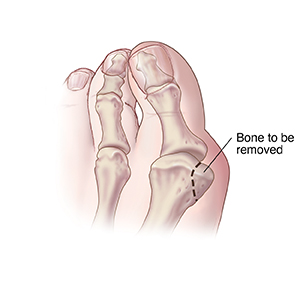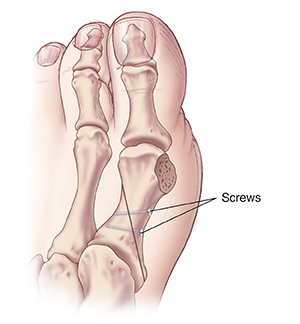Foot Surgery: Bunions
A bunion is a painful bony bump on the inside of the foot at the big toe joint. Sometimes the distance between the first and second metatarsal bones of the foot is greater than normal. This can make the big toe turn toward the other toes. A mild bunion may then form. This causes foot pain and swelling.
Bunions are most often found near the joint at the base of the big toe. They tend to run in families. They may cause pain, swelling, and skin irritation. Wearing tight shoes can cause bunions. Tight shoes can also make a bunion worse.
Bunions vary from mild to severe. They can be treated in many ways. Most bunions can be managed by wearing the correct shoes and other measures. Surgery may be advised if you have severe pain and trouble walking even if you try different shoes and other nonsurgical treatments. The surgical methods below may be options if you need surgery.
Head chevron osteotomy
The first metatarsal bone is cut. Its head is moved closer to the second metatarsal bone. A screw or pin can be used to hold the first metatarsal bone in position. The bony bump is also removed. You will need to wear a surgical shoe or boot for a few weeks. This is to protect your foot while healing.


Base osteotomy
With this procedure, a wedge of bone is removed from the first metatarsal bone. This is farther back than in the head chevron osteotomy. The bone is moved closer to the second metatarsal bone. It's held together with screws or a plate. The bony bump is also removed. Your foot may be placed in a cast, shoe, or boot to heal correctly. You may be asked not to bear weight on this foot for a few weeks.


Soft tissue repair
This procedure tightens the loose ligaments and tendons. It also loosens the tight ones around the bunion. It can be combined with an osteotomy procedure.
Lapidus procedure
With this procedure, the first metatarsal is fused with a small bone in your midfoot called the medial cuneiform. This procedure is often used to correct a bunion with a very large angle. Or it's done when you have increased movement or instability through the tarsometatarsal joint. The Lapidus procedure may be done with an osteotomy or other procedure to correct the bunion.
Fusion or removal of part of the joint
This is typically only done if there is severe arthritis or damage of the joint itself.